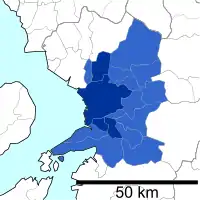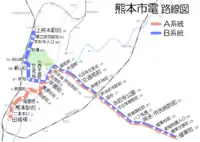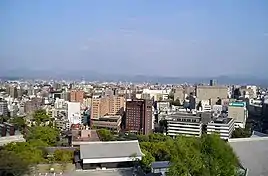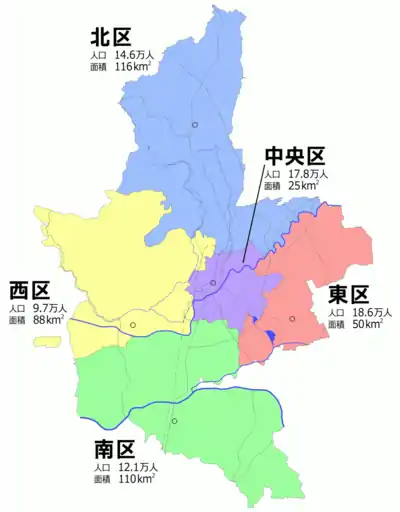Kumamoto
Kumamoto (熊本市, Kumamoto-shi) is the capital city of Kumamoto Prefecture on the island of Kyushu, Japan. As of June 1, 2019, the city has an estimated population of 738,907 and a population density of 1,893 people per km2. The total area is 390.32 km2.
Kumamoto
熊本市 | |
|---|---|
Designated city | |
| Kumamoto City | |
From top left: Skyline view of Kumamoto City from Kumamoto Castle, Kumamoto Castle, Kumamoto Shintoshin Plaza, Fujisaki Hachimangū shrine, Downtown Shimotori-Shintengai of Kumamoto City, Suizenji Park, Kumamoto Sakuramachi Bus Terminal | |
 Flag  Emblem | |
| Nickname: The Heart of Kyushu | |
 Location of Kumamoto in Kumamoto Prefecture | |
 Kumamoto Location in Japan | |
| Coordinates: 32°48′11″N 130°42′28″E | |
| Country | Japan |
| Region | Kyushu |
| Prefecture | Kumamoto Prefecture |
| First official recorded | 558 AD |
| City Settled | April 1, 1889 |
| Government | |
| • Mayor | Kazufumi Ōnishi[1][2] |
| Area | |
| • Total | 390.32 km2 (150.70 sq mi) |
| Population (June 1, 2019) | |
| • Total | 738,907 |
| • Density | 1,900/km2 (4,900/sq mi) |
| Time zone | UTC+09:00 (JST) |
| Climate | Cfa |
| Website | www |
| Symbols | |
| Bird | Great tit |
| Flower | Camellia |
| Tree | Ginkgo |


Greater Kumamoto (熊本都市圏) had a population of 1,461,000, as of the 2000 census. As of 2010, Kumamoto Metropolitan Employment Area has a GDP of US$39.8 billion.[3][4] It is not considered part of the Fukuoka–Kitakyushu metropolitan area, despite their shared border. The city was designated on April 1, 2012, by government ordinance.
History
Shokuhō period
Katō Kiyomasa, a contemporary of Toyotomi Hideyoshi, was made daimyō of half of the (old) administrative region of Higo in 1588. Afterwards, Kiyomasa built Kumamoto Castle. Due to its many innovative defensive designs, Kumamoto Castle was considered impenetrable, and Kiyomasa enjoyed a reputation as one of the finest castle-builders in Japanese history.
Edo period
After Kiyomasa died in 1611, his son, Tadahiro, succeeded him. In 1632, Tadahiro was removed by Tokugawa Iemitsu and replaced with the Hosokawa clan.
Hosokawa Tadatoshi, the third lord of Kumamoto, was the patron of the artist[5] and swordsman Miyamoto Musashi[6]
 Statue of Hosokawa Tadatoshi within Suizen-ji Jōju-en.
Statue of Hosokawa Tadatoshi within Suizen-ji Jōju-en. Mon of the Hosokawa clan.
Mon of the Hosokawa clan.

Meiji period
The current administrative body of the City of Kumamoto was founded on April 1, 1889.
Showa period
On July 1, 1945, near the end of World War II, Kumamoto was bombed in an Allied air raid that destroyed one square mile, which was 20% of the city's area.[8]
After WWII
After the war, the Japanese Buddhist monk Nichidatsu Fujii decided to construct a Peace Pagoda atop Mount Hanaoka in the city to commemorate all those lost in war and to promote peace.[9] Inaugurated in 1954, it was the first of over 80 Peace Pagodas built by Fujii and his followers all over the world.[10]
Heisei period
On February 1, 1991, the towns of Akita, Kawachi, Tenmei, and Hokubu (all from Hōtaku District) were merged into Kumamoto. On October 6, 2008, the town of Tomiai (from Shimomashiki District) was merged into Kumamoto. On March 23, 2010, the town of Jōnan (also from Shimomashiki District) and the town of Ueki (from Kamoto District) were merged into Kumamoto.[11]
A series of earthquakes struck the area beginning April 14, 2016, including a tremor with moment magnitude 7.1 early in the morning of April 16, 2016.[12]
Geography
Climate
Kumamoto has a humid subtropical climate (Köppen climate classification Cfa) with hot, humid summers and cool winters. There is significant precipitation throughout the year, especially during June and July. The average annual temperature in Kumamoto is 17.2 °C (63.0 °F). The average annual rainfall is 2,007.0 mm (79.02 in) with June as the wettest month. The temperatures are highest on average in August, at around 28.4 °C (83.1 °F), and lowest in January, at around 6.0 °C (42.8 °F). The highest temperature ever recorded in Kumamoto was 38.8 °C (101.8 °F) on 17 July 1994; the coldest temperature ever recorded was −9.2 °C (15.4 °F) on 11 February 1929.
| Climate data for Kumamoto (1991−2020 normals, extremes 1890−present) | |||||||||||||
|---|---|---|---|---|---|---|---|---|---|---|---|---|---|
| Month | Jan | Feb | Mar | Apr | May | Jun | Jul | Aug | Sep | Oct | Nov | Dec | Year |
| Record high °C (°F) | 22.5 (72.5) |
26.4 (79.5) |
27.4 (81.3) |
30.7 (87.3) |
34.4 (93.9) |
36.1 (97.0) |
38.8 (101.8) |
38.5 (101.3) |
37.0 (98.6) |
33.7 (92.7) |
28.9 (84.0) |
24.6 (76.3) |
38.8 (101.8) |
| Average high °C (°F) | 10.7 (51.3) |
12.4 (54.3) |
16.1 (61.0) |
21.4 (70.5) |
26.0 (78.8) |
28.1 (82.6) |
31.8 (89.2) |
33.3 (91.9) |
30.1 (86.2) |
25.0 (77.0) |
18.8 (65.8) |
12.9 (55.2) |
22.2 (72.0) |
| Daily mean °C (°F) | 6.0 (42.8) |
7.4 (45.3) |
10.9 (51.6) |
15.8 (60.4) |
20.5 (68.9) |
23.7 (74.7) |
27.5 (81.5) |
28.4 (83.1) |
25.2 (77.4) |
19.6 (67.3) |
13.5 (56.3) |
8.0 (46.4) |
17.2 (63.0) |
| Average low °C (°F) | 1.6 (34.9) |
2.6 (36.7) |
5.9 (42.6) |
10.6 (51.1) |
15.6 (60.1) |
20.2 (68.4) |
24.2 (75.6) |
24.8 (76.6) |
21.2 (70.2) |
14.9 (58.8) |
8.8 (47.8) |
3.4 (38.1) |
12.8 (55.0) |
| Record low °C (°F) | −9.2 (15.4) |
−9.2 (15.4) |
−6.9 (19.6) |
−2.5 (27.5) |
1.3 (34.3) |
7.1 (44.8) |
14.3 (57.7) |
15.3 (59.5) |
6.7 (44.1) |
0.5 (32.9) |
−3.8 (25.2) |
−7.9 (17.8) |
−9.2 (15.4) |
| Average precipitation mm (inches) | 57.2 (2.25) |
83.2 (3.28) |
124.8 (4.91) |
144.9 (5.70) |
160.9 (6.33) |
448.5 (17.66) |
386.8 (15.23) |
195.4 (7.69) |
172.6 (6.80) |
87.1 (3.43) |
84.4 (3.32) |
61.2 (2.41) |
2,007 (79.02) |
| Average snowfall cm (inches) | 1 (0.4) |
0 (0) |
0 (0) |
0 (0) |
0 (0) |
0 (0) |
0 (0) |
0 (0) |
0 (0) |
0 (0) |
0 (0) |
0 (0) |
1 (0.4) |
| Average precipitation days (≥ 0.5 mm) | 8.1 | 9.0 | 11.4 | 10.7 | 10.4 | 15.2 | 13.3 | 11.3 | 10.4 | 7.2 | 8.3 | 8.3 | 123.5 |
| Average relative humidity (%) | 70 | 67 | 66 | 65 | 67 | 76 | 76 | 72 | 71 | 69 | 72 | 71 | 70 |
| Mean monthly sunshine hours | 133.0 | 141.1 | 169.6 | 184.0 | 194.3 | 130.8 | 176.7 | 206.0 | 176.4 | 187.1 | 153.7 | 143.4 | 1,996.1 |
| Source: Japan Meteorological Agency[13] | |||||||||||||
Wards
Since April 1, 2012, Kumamoto has five wards (ku):
| Wards of Kumamoto | ||||
|---|---|---|---|---|
| Place Name | Map of Kumamoto | |||
| Rōmaji | Kanji | Color | ||
| 1 | Kita-ku | 北区 | Blue |
|
| 2 | Nishi-ku | 西区 | Yellow | |
| 3 | Chuo-ku | 中央区 - (administrative center) | Purple | |
| 4 | Higashi-ku | 東区 | Red | |
| 5 | Minami-ku | 南区 | Green | |
Surrounding municipalities
- Uki
- Kikuchi
- Tamana
- Uto
- Yamaga
- Kōshi
- Mashiki
- Kōsa
- Kashima
- Kikuyō
- Mifune
- Gyokuto
Demographics
Per Japanese census data, the population of Kumamoto in 2020 is 738,865 people.[14] Kumamoto has been conducting censuses since 1920.
|
|
| ||||||||||||||||||||||||||||||||||||||||||||||||||||||||||||||||||||||||
| Kumamoto population statistics[14] | ||||||||||||||||||||||||||||||||||||||||||||||||||||||||||||||||||||||||||
Government
Kazufumi Ōnishi has been the city's mayor since December 2014.[15]
Transportation







Local public transport is provided by the Kumamoto City Transportation Bureau.
Airports
Kumamoto Airport is located in nearby Mashiki.
High-speed rail
On March 12, 2011, work on the shinkansen (high-speed bullet train) network was completed, establishing a direct high-speed rail link to Tokyo via Fukuoka's Hakata station.
- Kyushu Railway Company(JR Kyushu)
- Kyushu Shinkansen:- Kumamoto Station -
Conventional lines
The JR Kumamoto station provides rail links to Japan's extensive rail network.
- Kyushu Railway Company(JR Kyushu)
- Kagoshima Main Line:- Tabaruzaka - Ueki - Nishizato - Sōjōdaigakumae - Kami-Kumamoto - Kumamoto - Nishi-Kumamoto - Kawashiri - Tomiai -
- Hōhi Main Line:Kumamoto - Heisei - Minami-Kumamoto - Shin-Suizenji - Suizenji - Tōkai-Gakuen-mae - Tatsutaguchi - Musashizuka - Hikarinomori -
- Kumamoto Electric Railway
- Kikuchi Line:Kami-Kumamoto - Kankanzaka - Ikeda Station - Uchigoshi - Tsuboigawa-kōen - Kita-Kumamoto - Kamei - Hakenomiya - Horikawa -
- Fujisaki Line:Kita-Kumamoto - Kurokamimachi - Fujisakigū-mae
Tramways
Trams run to a few suburbs near the downtown area.
- Kumamoto City Transportation Bureau
Bus
A large bus terminus, called the Kotsu Centre, provides access to both local and intercity destinations.
Taxi
Several local taxi companies serve the Kumamoto metropolitan area and are the only 24-hour public transport in the city.
Expressways
.png.webp) Kyushu Expressway
Kyushu Expressway
Japan National Route
 Japan National Route 3
Japan National Route 3 Japan National Route 57
Japan National Route 57 Japan National Route 208
Japan National Route 208 Japan National Route 218
Japan National Route 218 Japan National Route 219
Japan National Route 219 Japan National Route 266
Japan National Route 266 Japan National Route 387
Japan National Route 387 Japan National Route 443
Japan National Route 443 Japan National Route 445
Japan National Route 445 Japan National Route 501
Japan National Route 501
Seaports
- Port of Kumamoto
Ferry
- Kyusyu Shosen:Kumamoto - Shimabara
- Kumamoto-Ferry:Kumamoto - Shimabara
- Korean Marine Transport:Kumamoto - Busan
Education
Universities
- Kumamoto University
- Prefectural University of Kumamoto
- Kumamoto Gakuen University
- Sojo University
- Kyūshū Lutheran College
- Shokei College
- Shokei Gakuin University
- Tokai University
Landmarks
Kumamoto Castle

The city's most famous landmark is Kumamoto Castle, a large and once extremely well fortified Japanese castle. The donjon (castle central keep) is a concrete reconstruction built in the 1970s, but several ancillary wooden buildings from the original castle remain. The castle was assaulted during the Satsuma Rebellion and sacked and burned after a 53-day siege. It was during this time that the tradition of eating basashi (raw horse meat) originated. Basashi remains popular in Kumamoto and, to a lesser extent, elsewhere in Japan, although these days it is usually considered a delicacy.
Within the outer walls of Kumamoto Castle is the Hosokawa Gyobu-tei, the former residence of the Higo daimyō. This traditional wooden mansion has a fine Japanese garden located on its grounds.
Religious sites
The first of many peace pagodas around the world was erected by Japanese Buddhist monk Nichidatsu Fujii atop Mount Hanaoka beginning 1947.[18] Inaugurated in 1954, it was the first of over 80 built by Fujii and his followers all over the world.[19]
Kumamoto is also the location of Takahashi Inari Shrine and Fujisaki Hachimangū.
Suizenji area
Kumamoto is home to Suizen-ji Jōju-en, a formal garden neighboring Suizenji Temple approximately 3 kilometers southeast of Kumamoto Castle. Suizenji Park is also home to the Suizenji Municipal Stadium, where the city's football team, Roasso Kumamoto, used to play regularly. The team now uses the larger KKWing Stadium in Higashi Ward.
Other notable sites
Miyamoto Musashi lived the last part of his life in Kumamoto. His tomb and the cave where he resided during his final years (known as Reigandō, or "spirit rock cave") are situated close by. He penned the famous Go Rin no Sho (The Book of Five Rings) whilst living here.
The downtown area has a commercial district centred on two shopping arcades, the Shimotori and Kamitori, which extend for several city blocks. The main department stores are located here along with a large number of smaller retailers, restaurants, and bars. Many local festivals are held in or near the arcades.
Cultural venues include the Kumamoto Prefectural Museum of Art and Kumamoto Prefectural Theater.
Culture
Sports teams
- Hinokuni Salamanders of the baseball Kyusyu Asia League are based in Kumamoto.
- Roasso Kumamoto in J.League is the local football club.
- Kumamoto Volters of the basketball B.League are based in Kumamoto.
- Forest Leaves Kumamoto of the Volleyball V.League(V2)are based in Kumamoto.
 Kumamoto Fujisakidai Baseball Stadium
Kumamoto Fujisakidai Baseball Stadium Egao Kenko Stadium
Egao Kenko Stadium Kumamoto Prefectural Gymnasium
Kumamoto Prefectural Gymnasium Kumamoto City Synthesis Gymnasium
Kumamoto City Synthesis Gymnasium
Sporting events
The Kumamoto Castle Marathon is a yearly event in Kumamoto City. It was established in commemoration of Kumamoto becoming a designated city in 2012.[20] The city also hosted the 1997 World Men's Handball Championship and the 2019 World Women's Handball Championship.
External relations
Twin towns/sister cities
Kumamoto City is twinned with the following cities.
International
 Billings, Montana, United States
Billings, Montana, United States Bristol, South West England, United Kingdom
Bristol, South West England, United Kingdom Guilin, Guangxi, People's Republic of China
Guilin, Guangxi, People's Republic of China Heidelberg, Baden-Württemberg, Germany (since 1992)[21]
Heidelberg, Baden-Württemberg, Germany (since 1992)[21] Helena, Montana, United States
Helena, Montana, United States San Antonio, Texas, United States (since 1987)[22]
San Antonio, Texas, United States (since 1987)[22] Ulsan, South Korea (since 2010)
Ulsan, South Korea (since 2010) Kaohsiung, Taiwan (since 2017)[23]
Kaohsiung, Taiwan (since 2017)[23]
Notable people
- Aimer, pop singer and lyricist.
- Chisato Moritaka, pop singer and lyricist.
- Eiichiro Oda, manga artist, author of One Piece.
- Go Shiozaki, Japanese professional wrestler, currently signed to the Pro Wrestling Noah promotion and Chairman of the Noah Wrestlers' Association.
- Higonoumi Naoya, sumo wrestler.
- Inoue Kowashi, statesman.
- Isao Yukisada, film director.
- Kaji Yajima, educator, pacifist, president of the WCTU in Japan.
- Masahiko Kimura, judoka.
- Momoko Ueda, professional golfer.
- Noriko Kubo, Japanese female fencer.
- Rie Kugimiya, voice actress.
- Sayaka Hirota, Japanese badminton player.
- Sayuri Ishikawa, enka singer
- Seiki Yoshioka, Japanese professional wrestler
- Shōdai Naoya, sumo wrestler.
- Tochihikari Masayuki, sumo wrestler.
- Tadako Urata, ophthalmologist
- Yōko Shimada, actress.
- Yokoi Shōnan, scholar and political reformer.
- Yuri Masuda, vocalist from the group m.o.v.e.
- Yuki Fukushima, Japanese badminton player.
- Yuta Iwasada, Japanese baseball player.
References
- "Kumamoto City". JAPAN SHOWCASE. The Japan Times. Retrieved 24 October 2015.
- 市長名の検索結果 (in Japanese). Japan Association of City Mayors. Retrieved 24 October 2015.
- Yoshitsugu Kanemoto. "Metropolitan Employment Area (MEA) Data". Center for Spatial Information Science, The University of Tokyo.
- Conversion rates - Exchange rates - OECD Data
- "Art of Miyamoto Musashi". ecole-miyamoto-musashi.com. 2009. Retrieved August 12, 2020.
- Wilson, The Lone Samurai, pp. 104–105.
- "Mimasaka. Musashi Miyamoto". Mémorial Heiho Niten Ichi Ryu. 2018. Retrieved August 12, 2020.
- Craven, Wesley; Cate, James, eds. (1953). The Pacific: Matterhorn to Nagasaki. The Army Air Forces in World War II. Volume V. Chicago: The University of Chicago Press. p. 664. OCLC 256469807.
- Kisala, Robert (1999). Prophets of Peace: Pacifism and Cultural Identity in Japan's New Religions. University of Hawaii Press. pp. 52–53. ISBN 9780824822675.
- Stone, Jacqueline I. (2003). Queen, Christopher S.; Prebish, Charles S.; Keown, Damien (eds.). Action Dharma: New Studies in Engaged Buddhism. Psychology Press. p. 81. ISBN 9780700715947.
- "都道府県別市町村変更情報:福岡 Archived 2010-04-06 at the Wayback Machine." kokudo.or.jp. Retrieved on November 22, 2008. (in Japanese)
- "Japan earthquake: Powerful new tremor in Kumamoto". BBC News. 2016-04-15. Retrieved 2016-04-15.
- 気象庁 / 平年値(年・月ごとの値). Japan Meteorological Agency. Retrieved May 19, 2021.
- Kumamoto population statistics
- 市長のプロフィール (in Japanese). Kumamoto City. 3 December 2014. Retrieved 24 October 2015.
- "Japanese politicians force colleague with baby to leave chamber". TheGuardian.com. 24 November 2017.
- "A Japanese politician took her baby to work. Male colleagues made a fuss. - The Washington Post".
- Kisala, Robert (1999). Prophets of Peace: Pacifism and Cultural Identity in Japan's New Religions. University of Hawaii Press. pp. 52–53. ISBN 9780824822675.
- Stone, Jacqueline I. (2003). Queen, Christopher S.; Prebish, Charles S.; Keown, Damien (eds.). Action Dharma: New Studies in Engaged Buddhism. Psychology Press. p. 81. ISBN 9780700715947.
- Kumamoto Castle Marathon website Information on 2013 Kumamoto Castle Marathon Archived 2012-11-01 at the Wayback Machine
- "Twinning". City of Heidelberg. Archived from the original on 2011-06-10. Retrieved 2009-11-12.
- City of San Antonio International Relations Office. Retrieved 12 October 2011
- "Kumamoto Prefecture - the Council of Local Authorities for International Relations (CLAIR)".
External links
- Kumamoto City official website (in Japanese)
- Kumamoto City official website (in English)
 Kumamoto travel guide from Wikivoyage (in English)
Kumamoto travel guide from Wikivoyage (in English) Geographic data related to Kumamoto at OpenStreetMap
Geographic data related to Kumamoto at OpenStreetMap





.jpg.webp)

